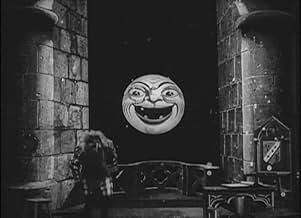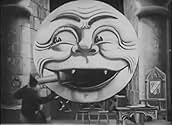ÉVALUATION IMDb
7,4/10
5,1 k
MA NOTE
Ajouter une intrigue dans votre langueAn astronomer falls asleep and has a strange dream involving a fairy queen and the Moon.An astronomer falls asleep and has a strange dream involving a fairy queen and the Moon.An astronomer falls asleep and has a strange dream involving a fairy queen and the Moon.
- Director
- Writer
- Stars
Jehanne d'Alcy
- Phoebe - la bonne fée
- (uncredited)
Georges Méliès
- L'astronome
- (uncredited)
Avis en vedette
I can't believe that no one else has commented on this yet. This amazing film was one of the first "story" films, with sets like a play. It is a wonderment and leaves so much inspiration for the imagination. It is not in popular circulation, but perhaps it should be. If you can get a chance to watch this one do at all costs. If you can't find it then just think of the Tonight Tonight video by the Smashing Pumpkins. It's about the same except they are separated by about one-hundred years and by a whole barrage of special effects. All in all they are both wonderful and interesting to look at.
Astronomer's Dream, The (1898)
*** (out of 4)
aka La Lune a un metre
An astronomer is in his office working when the devil and a woman appear to him and this sets off a strange dream, which includes the moon attacking him. This is another enjoyable film from Meiles as we get to see various magic tricks including the familiar gags of the astronomer going to sit down only to have the chair disappear. What really stands out in this film is the attack by the moon, which is perfectly done and leads to several laughs. I love Melies' design of the moon making it something to fear with its evil eyes and mouth. The special effects are quite nice throughout. This is certainly a good place for newbies to start.
*** (out of 4)
aka La Lune a un metre
An astronomer is in his office working when the devil and a woman appear to him and this sets off a strange dream, which includes the moon attacking him. This is another enjoyable film from Meiles as we get to see various magic tricks including the familiar gags of the astronomer going to sit down only to have the chair disappear. What really stands out in this film is the attack by the moon, which is perfectly done and leads to several laughs. I love Melies' design of the moon making it something to fear with its evil eyes and mouth. The special effects are quite nice throughout. This is certainly a good place for newbies to start.
Fantastic short film from pioneering filmmaker Georges Méliès. A great companion piece to his later classic, A Trip to the Moon (1902). That name was also given to this one when released in the US. The original (and more fitting) name is The Astronomer's Dream. The story to this is an astronomer who looks like Merlin is visited by a woman and a demon and has dreams about the moon. The special effects and sets are really cool, especially when you consider this film's age. Méliès was ahead of his time in many ways. Definitely worth a look for anyone into film history or silent shorts or anyone with a few minutes to spare. I can't imagine anyone seeing this and regretting it. Well, a-holes maybe.
This is actually a very elaborate fiction film for 1898. Made by Georges Méliès, it lasts over three minutes, when most films during the period lasted about a minute or less. Early cinema historian Frank Gray refers to this film as having consisted of three shots and 60 meters length. Yet, I can't precisely distinguish or separate shots or scenes in it, as the entire film takes place from a fixed framing and long-shot perspective. One could go to either extreme: saying that this is a single shot-scene film since its perspective is stationary, or you could say it consists of dozens of shots, including the trick splices for appearances, disappearances, substitutions and stop-motion animation, which is to say this film is a series of jump cuts.
"The Astronomer's Dream", however, does contain a three-part structure, I'd say. The bookend parts are of the astronomer safe within his laboratory, with the longer, middle part being the nightmare. There are also at least three slightly different decors used: the outer one with the telescope and the entire laboratory; a tighter, less furnished, yet similar one for closer views of the moon during the dream; and, briefly, a wall. Moreover, as indicated by this film having three entries in the Star catalogue, it was available to exhibitors in three parts, which was common then, as films were generally sold in 20-meter lengths. Regardless, this is a sophisticated narrative and production for its time.
The following year, Méliès would produce his first féerie film (fairy film), "Cinderella", which consists of at least four distinct scenes transitioned by dissolves. "Cinderella", albeit, is in the tableau, theatrical style of stationary shot-scenes, but it does distinguish spatially separate scenes for a more advanced narrative construction. One fiction film in 1898, Robert W. Paul's "Come Along Do!" also contained two spatially separate scenes with action continuing across them. "The Astronomer's Dream", however, was Méliès's then most elaborate and sophisticated dream or trick film, although it does contain a fairy godmother type in the goddess Phoebe, who protects the astronomer from attacks by demons, the moon and the rest of the nightmare. It's purely part of what Tom Gunning has referred to as "the cinema of attractions"; the attraction here being the magic or tricks accomplished mostly through substitution splices (a.k.a. stop substitutions), as well as theatrical props and transitions and a brief chalkboard animation within the scene. Today, these trick films hold up well and remain at least amusing because of Méliès's wacky and imaginative humor; their primitiveness is even part of their charm.
"The Astronomer's Dream", however, does contain a three-part structure, I'd say. The bookend parts are of the astronomer safe within his laboratory, with the longer, middle part being the nightmare. There are also at least three slightly different decors used: the outer one with the telescope and the entire laboratory; a tighter, less furnished, yet similar one for closer views of the moon during the dream; and, briefly, a wall. Moreover, as indicated by this film having three entries in the Star catalogue, it was available to exhibitors in three parts, which was common then, as films were generally sold in 20-meter lengths. Regardless, this is a sophisticated narrative and production for its time.
The following year, Méliès would produce his first féerie film (fairy film), "Cinderella", which consists of at least four distinct scenes transitioned by dissolves. "Cinderella", albeit, is in the tableau, theatrical style of stationary shot-scenes, but it does distinguish spatially separate scenes for a more advanced narrative construction. One fiction film in 1898, Robert W. Paul's "Come Along Do!" also contained two spatially separate scenes with action continuing across them. "The Astronomer's Dream", however, was Méliès's then most elaborate and sophisticated dream or trick film, although it does contain a fairy godmother type in the goddess Phoebe, who protects the astronomer from attacks by demons, the moon and the rest of the nightmare. It's purely part of what Tom Gunning has referred to as "the cinema of attractions"; the attraction here being the magic or tricks accomplished mostly through substitution splices (a.k.a. stop substitutions), as well as theatrical props and transitions and a brief chalkboard animation within the scene. Today, these trick films hold up well and remain at least amusing because of Méliès's wacky and imaginative humor; their primitiveness is even part of their charm.
This is another very early (19th century still!!) and simply MAGNIFICENT example of Georges Melies' magic: a queer 'science fiction' story (certainly one of the first EVER) about a scientist (played by Melies himself) who is hooked on his researches about the moon - which seems to take its revenge: first it comes alive on the drawing board, and when he looks at it through its telescope, it comes REALLY close to him, literally only 'a meter away', as the title says; and starts eating up everything in reach...
Here we have the great pleasure to enjoy more of the magician's cinematographic tricks he knew so perfectly well: people and things vanishing and reappearing, the drawn settings seemingly coming alive... THOSE are the 'little' shorts (with a running time of only about 3 minutes then) which led to today's movies with their special computer effects and almost unbelievable scenes - something that EVERY film fan should see in order to get to know the ORIGINS OF TODAY'S CINEMA!
Here we have the great pleasure to enjoy more of the magician's cinematographic tricks he knew so perfectly well: people and things vanishing and reappearing, the drawn settings seemingly coming alive... THOSE are the 'little' shorts (with a running time of only about 3 minutes then) which led to today's movies with their special computer effects and almost unbelievable scenes - something that EVERY film fan should see in order to get to know the ORIGINS OF TODAY'S CINEMA!
Le saviez-vous
- AnecdotesWhen this film was imported into the United States by producer Sigmund Lubin in 1899 he re-titled it A Trip to the Moon. However this has no relation to the 1902 film A Trip to the Moon. The original translated title is "The Moon at One Meter's Distance" or freely "The Moon at Arm's Length".
- ConnexionsFeatured in Castle: Punked (2010)
Meilleurs choix
Connectez-vous pour évaluer et surveiller les recommandations personnalisées
Détails
- Date de sortie
- Pays d’origine
- Langue
- Aussi connu sous le nom de
- The Astronomer's Dream; or, The Man in the Moon
- Lieux de tournage
- sociétés de production
- Consultez plus de crédits d'entreprise sur IMDbPro
- Durée
- 3m
- Couleur
- Mixage
- Rapport de forme
- 1.33 : 1
Contribuer à cette page
Suggérer une modification ou ajouter du contenu manquant




















